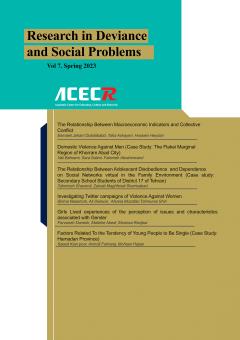-
-
-
Open Access Article
1 - Sociological Explanation of Women's Violence Against Men
Parvaneh Danesh mihamad javad zahedi mazandarani nazanin khosh simaThe general view of family violence is usually referred to violence by men against women or other family members, but reports in this field show that sometimes men are victimized by women's violence. The main objective of this research is the sociological explanation o MoreThe general view of family violence is usually referred to violence by men against women or other family members, but reports in this field show that sometimes men are victimized by women's violence. The main objective of this research is the sociological explanation of women's violence against men. This research was conducted in a qualitative method and data was analyzed with the method of ground theory. The sample includes married men who have experienced violence in Tehran. The method of selecting the samples was purposeful and the sample volume reached saturation during the research after the 10th interview. The analyzes were done by three types of open coding, central coding and selective coding. The findings of the research include: background conditions affecting women's violence against men, including: 1- cultural issues, 2- social issues, 3- financial issues, 4- occupational and organizational conditions, 5- mental and psychological problems in the family, 6- history of addiction. In the family, 7- Knowledge of life skills; Intervening factors affecting the strategy of women's violence against men include: 1- personality difference, 2- cultural difference, 3- age difference, 4- difference in financial issues, 5- difference in the type of need, 6- marital beliefs, 7- gender beliefs; Causal conditions affecting women's violence against men include: 1- broken relationships, 2- intertwined relationships, 3- inappropriate family experiences, 4- occupational-organizational factors, 5- communication problems at work, 6- social factors, 7- cultural factors; Action and interaction strategies are: 1- Unhealthy communication behaviors 2- Retaliatory interaction pattern 3- Lack of love and intimacy; The consequences are: 1- Psychological injuries 2- The lack of power of the man in the family 3- Separation 4- Risky behaviors 5- Damage to the children 6- Weakening of the family foundation 7- Lack of household financial management; The research results show the existence of violence against men in the family and the consequences of this type of violence weaken the family institution. Manuscript profile -
Open Access Article
2 - Girls Lived experiences of the perception of issues and characteristics associated with Gender
Parvaneh Danesh maliheh abedi morteza ranjbarPerception and experience of gender as an established pattern can play a significant role in individuals' social and educational actions. This study focuses on exploring the lived experiences of female students from childhood. The research method employed is qualitative MorePerception and experience of gender as an established pattern can play a significant role in individuals' social and educational actions. This study focuses on exploring the lived experiences of female students from childhood. The research method employed is qualitative with a phenomenological approach. The sample consists of seventeen female students from Tehran. The sample size was determined based on theoretical saturation principle. Data collection was done through semi-structured interviews, and data analysis was conducted using thematic analysis. After gathering the data, the narratives of the students regarding their experiences of girlhood were coded and categorized. Three main themes emerged from the interviews, which further yielded nine sub-themes and twenty-three concepts during the analysis. The main themes include femininity traits, girlhood issues, and girlhood agency. The sub-themes encompass exclusive traits of girls, gender differences, being a good girl, gender discrimination, gender perspectives, gender stereotypes, changing attitudes, family role in issues, and girlhood strategies. Examining the lived experiences of girls reveals that although the examined samples reproduce some of the common emotional and behavioral characteristics associated with girlhood, the students' narratives indicate that they face limitations and deprivation in society due to their gender. Moreover, they feel a sense of injustice and discrimination in their social and daily lives. The students under study express dissatisfaction with the societal misconceptions about girls and demand more agency and empowerment for girls in society. Manuscript profile
List of Articles Parvaneh Danesh
-
The rights to this website are owned by the Raimag Press Management System.
Copyright © 2017-2024

